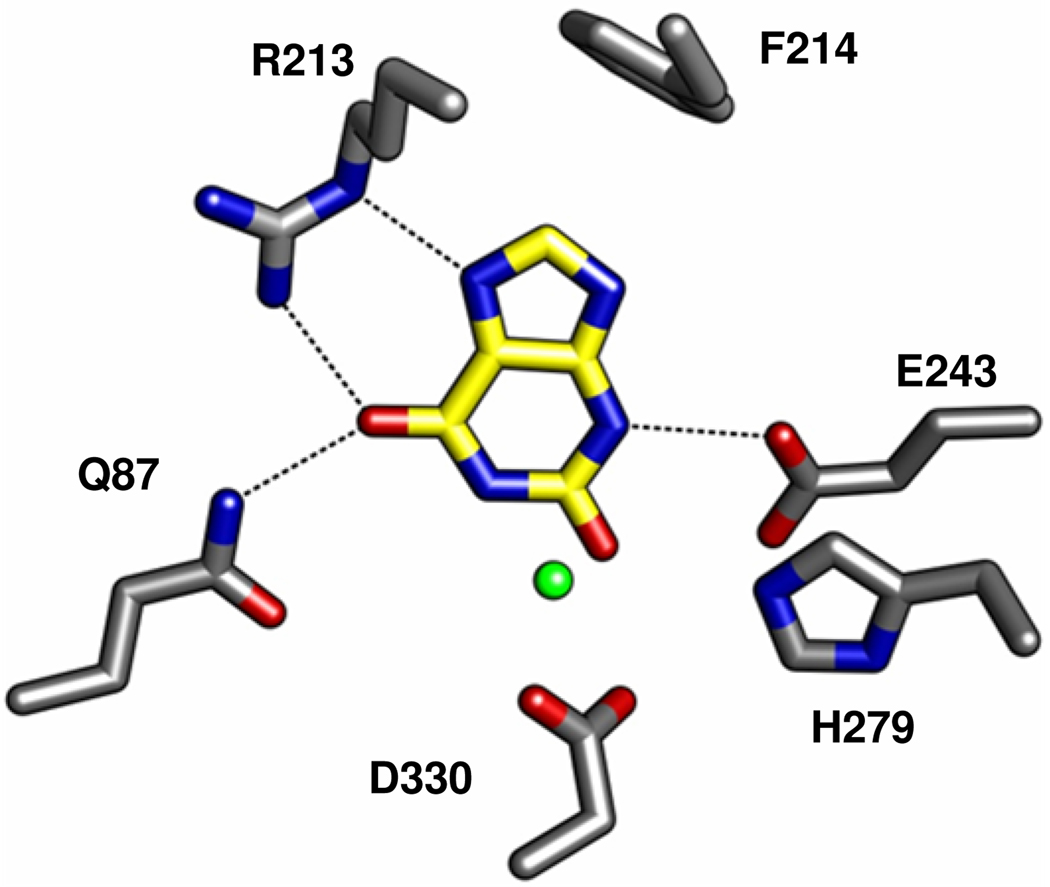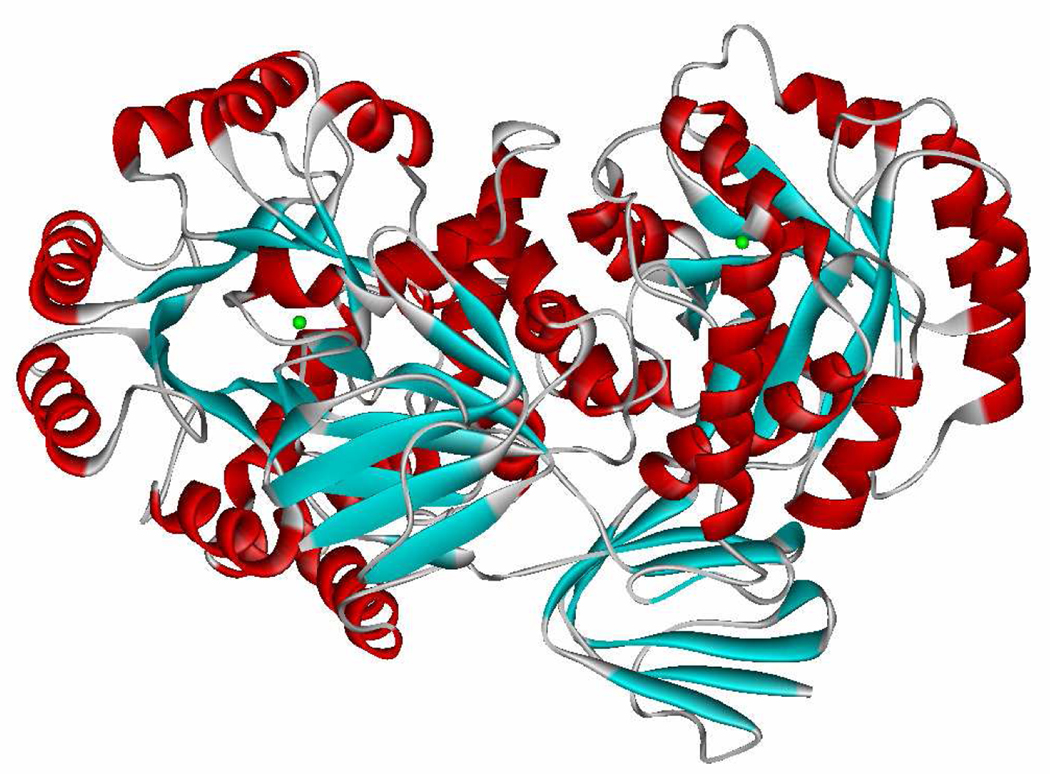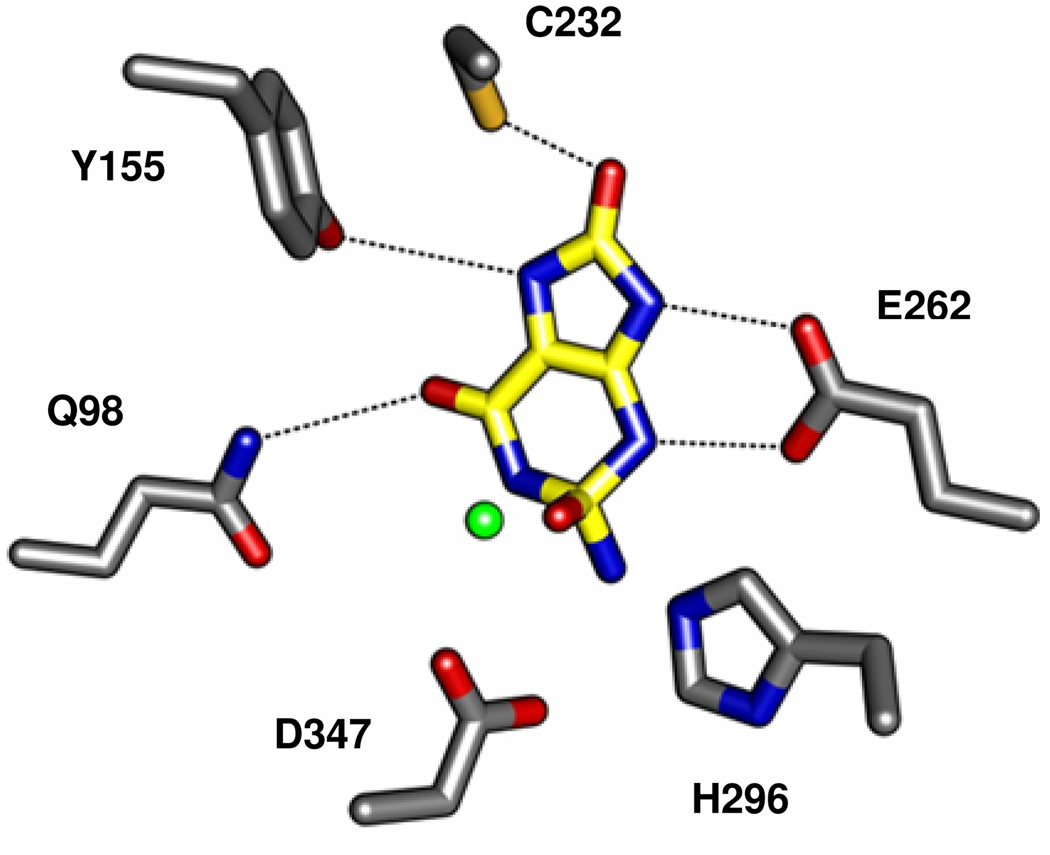Abstract
An enzyme from Pseudomonas aeruginosa, Pa0142 (gi|9945972) has been identified for the first time that is able to catalyze the deamination of 8-oxoguanine (8-oxoG) to uric acid. 8-Oxoguanine is formed by the oxidation of guanine residues within DNA by reactive oxygen species and this lesion results in the G:C to T:A transversions. The value of kcat/Km for the deamination of 8-oxoG by Pa0142 at pH 8.0 and 30 °C is 2.0 × 104 M−1 s−1. This enzyme can also catalyze the deamination of isocystosine and guanine at rates that are approximately an order of magnitude slower. The three-dimensional structure of a homologous enzyme (gi|44264246) from the Sargasso Sea has been determined by x-ray diffraction methods to a resolution of 2.2Å (PDB code: 3h4u). The enzyme folds as a (β/α)8− barrel and it is a member of the amidohydrolase superfamily with a single zinc in the active site. This enzyme catalyzes the deamination of 8-oxoG with a value of kcat/Km of 2.7 × 105 M−1 s−1. Computational docking of potential high energy intermediates for the deamination reaction to the x-ray crystal structure suggests that the active site binding of 8-oxoG is facilitated by hydrogen bond interactions from a conserved glutamine that follows β-strand 1 with O6, a conserved tyrosine that follows β-strand 2 with N7, and a conserved cysteine residue that follows β-strand 4 with O8. A bioinformatic analysis of available protein sequences suggest that approximately 200 other bacteria possess an enzyme capable of catalyzing the deamination of 8-oxoG.
In Nature, everything that is made is unmade. Thus, for every pathway for the biosynthesis of a given metabolite there are complementary transformations for degradation and recycling of these building blocks back into living organisms. This phenomenon is particularly important for those compounds that interfere with reproduction and/or the maintenance of genetic information. One such compound is 8-oxoguanine (8-oxoG) which is formed by the oxidation of guanine within DNA by reactive oxygen species (Scheme 1).1 If uncorrected this modification leads to the incorporation of 8-oxoG:A mismatches and eventual G:C to T:A transversions.2 Such mutagenic lesions can be excised from DNA by 8-oxoguanine-DNA glycosylase to liberate 8-oxoG as the free base.3 How then is 8-oxoG further metabolized? In many organisms guanine is first deaminated to xanthine and then oxidized to uric acid. However, 8-oxoG is not a substrate for any of the known guanine deaminases and thus this compound cannot enter the established routes for purine degradation. Chemically, the most likely transformation is the deamination of 8-oxoG directly to uric acid, but to the best of our knowledge an enzyme catalyzing this reaction has not been discovered. This Communication describes the systematic identification and structural elucidation of a bacterial enzyme that efficiently deaminates 8-oxoG directly to uric acid.
Scheme 1.
The amidohydrolase superfamily (AHS) contains most of the enzymes known to catalyze the deamination of aromatic bases.4 Well known examples include adenosine, cytosine, and guanine deaminase. The hallmark for these enzymes within the AHS is an HxxE motif that is found at the C-terminus of β-strand 5 within the context of a (β/α)8 structural fold. Approximately 1300 unique proteins sequences bearing this signature can be identified in the cluster of orthologous groups as cog0402 from the completely sequenced bacterial genomes. In a search for an undiscovered subcluster of enzymes that has the ability to deaminate 8-oxoG, it was logical to assume that the recognition elements for the binding of this substrate are similar for the association of guanine to guanine deaminase. The fully conserved residues that directly contact guanine/xanthine in the active site of human guanine deaminase are shown in Figure 1.5 In this complex, Asp-330, Glu-243, and His-279 form a catalytic triad of residues that are responsible for proton transfers from the activated water molecule to the two reaction products, xanthine and ammonia. In addition, the O6 carbonyl group of xanthine hydrogen bonds with the side chain of Gln-87, and the guanidino group of Arg-213 hydrogen bonds with O6 and N7 of the substrate. The phenyl ring of Phe-214 caps the size of the binding site.
Figure 1.
Active site structure of human guanine deaminase with the product xanthine (PDB code: 2uz9). Zinc is denoted as a green sphere and xanthine is shown with yellow carbon atoms.
The largest subcluster of AHS enzymes within cog0402 that has a global BLAST e-value of less than 10−70 for which the catalytic function is unknown contains ~200 unique protein sequences. Members of this subcluster share the conserved catalytic triad of residues found in the active site of guanine deaminase and also have the conserved glutamine residue at the C-terminus of β-strand 1. However, the conserved arginine and phenylalanine residues at the C-terminus of β-strand 4 in guanine deaminase are missing and are replaced with cysteine and serine, respectively. This subcluster of sequences in cog0402 became the prime target for the discovery of an enzyme capable of deaminating 8-oxoG. To experimentally address this proposal one of the proteins within this subcluster of sequences (Pa0142 from Pseudomonas aeruginosa PA01, gi|9945972) was expressed, purified to homogeneity, and the reaction profile interrogated with a library of potential substrates.
Pa0142 was assayed against a library of more than 50 compounds with the potential for deamination of an aromatic base. Compounds in this library included pyrimidines, purines, and pterins as simple bases plus nucleosides and nucleotides. Formation of ammonia was monitored by a coupled enzyme assay using glutamate dehydrogenase, NADH, and α-ketoglutarate at pH 8.0.6 Product formation in each case was confirmed by mass spectrometry and UV spectroscopy. Of the compounds tested, activity could only be detected with 8-oxoguanine (1), guanine (2), isocytosine (3), and ammeline (4) (Scheme 1). The limited solubility of 8-oxoG prevented an accurate measurement of kcat and Km but the value of kcat/Km of (2.0 ± 0.1) × 104 M−1 s−1 is an order of magnitude higher than the next best compound tested. For guanine (2) the values of kcat, Km and kcat/Km are 3.3 ± 0.6 s−1, 2.6 ± 0.6 mM and (1.3 ± 0.4) × 103 M−1 s−1, respectively. For isocytosine (3) the values of kcat, Km, and kcat/Km are 3.9 ± 0.1 s−1, 1.8 ± 0.1 mM and (2.2 ± 0.1)×103 M−1 s−1, respectively. These results clearly support the conclusion that Pa0142 is an 8-oxoguanine deaminase (8-OGD).
The ability of Pa0142 to deaminate guanine prompted a reassessment of whether prototypical guanine deaminases can utilize 8-oxoG as a substrate. Two putative guanine deaminases were cloned, purified, and characterized: Pa0134 from P. aeruginosa (gi|15595332) and b2883 from Escherichia coli K12 (gi|16130785). These enzymes efficiently catalyze the deamination of guanine but not any other compounds. For Pa0134 the values of kcat, Km, and kcat/Km for guanine are 21 ± 2 s−1, 0.50 ± 0.09 mM and (4.2 ± 0.9) × 104 M−1 s−1, respectively. For b2883 the values of kcat, Km and kcat/Km are 12.5 ± 0.2 s−1, 0.15 ± 0.01 mM and (8.1 ± 0.4) × 104 M−1 s−1, respectively. The maximal rate constant for the deamination of 8-oxoG is less than 5 × 10−3 s−1.
Attempts to crystallize Pa0142 have thus far failed. However, a homologous protein, identified from environmental DNA sequencing efforts in the Sargasso Sea (gi|44264246), was purified, crystallized, and its 3-dimensional structure determined by X-ray diffraction methods. This protein is 43% identical in protein sequence to Pa0142 and it is 98% identical to a protein of unknown function from Burkholderia sp. 383 (Bcep18194_A5267). The gene was codon-optimized for expression in E. coli, synthesized, and TOPO (Invitrogen, USA) cloned into a vector that yields a protein with a non-cleavable histidine tag. The sequence and expression/purification details are available from the PepcDB database (http://pepcdb.pdb.org/) under targetID "NYSGXRC-9236e" and the plasmid is available from the PSI Material Repository (psimr.asu.edu). The protein (6.2 mg/mL) crystallized in the presence of 0.5 mM ZnCl2 and 2.8 M sodium acetate and the structure was determined to a resolution limit of 2.2Å using data collected at the NSLS X4A beamline at Brookhaven National Laboratory (PDB code: 3h4u; see Table S1).
The Pa0142 homologue is more active than Pa0142 for the deamination of guanine, isocytosine, and 8-oxoguanine. For 8-oxoG, the value of kcat/Km is (2.7 ± 0.1) × 105 M−1 s−1. With isocytosine as a substrate the values of kcat, Km and kcat/Km are 62 ± 2 s−1, 1.6 ± 0.2 mM, and (3.9 ± 0.5) × 104 M−1 s−1, respectively. Kinetic constants of 52 ± 3 s−1, 1.0 ± 0.1 mM and (5.2 ± 0.6) × 104 M−1 s−1 were obtained for kcat, Km and kcat/Km, respectively, using guanine as a substrate. No activity was obtained with any of the substituted pterins that were tested.
The structure of the dimeric enzyme is presented in Figure 2. A single zinc ion is bound in the active site. The divalent cation is coordinated to two histidine residues (H93 and H95) that follow β-strand 1 and another histidine from β-strand 5 (H259). The coordination scheme is completed by the interaction of the side chain carboxylate group of an aspartate from β-strand 8 (D347) and a water molecule. The metal ligation scheme is identical to that previously observed for cytosine, guanine, and adenosine deaminases.4
Figure 2.
Ribbon representation of 8-oxoguanine deaminase (PDB code: 3h4u).
The Pa0142 homologue has a conserved glutamine residue (Q98) in the active site that is homologous to Q87 in human guanine deaminase. However, the fully conserved arginine and phenylalanine residues that complete the binding pocket for guanine/xanthine in the active site are missing. These residues, from the C-terminus of β-strand 4, are substituted with a cysteine (C232) and serine (S233), respectively. C232 is positioned to donate a hydrogen bond to the carbonyl group at C8 of 8-oxoG and E262 can facilitate a proton transfer to N3 during catalysis. A fully conserved tyrosine residue (Y155) may additionally interact with N7. A computational model for these interactions with a putative tetrahedral intermediate is presented in Figure 3.7,8
Figure 3.
Active site model for 8-oxoguanine deaminase with a putative tetrahedral intermediate for deamination of 8-oxoG.
Summary
An enzyme from P. aeruginosa has been discovered that efficiently deaminates 8-oxoguanine to uric acid. A database search has identified more than 200 other organisms that possess at least one protein that is >35% identical in sequence to this enzyme (see Table S2). The 3-dimensional structure of 8-OGD has been determined and computational methods have been utilized to rationalize the binding of 8-oxoG in the active site. Experiments designed to verify the in vivo activity of Pa0142 are in progress.
Supplementary Material
Acknowledgment
This work was supported in part by the NIH (GM071790 and GM074945).
Footnotes
Supporting Information Available: This material is available free of charge via the Internet at http://pubs.acs.org.
References
- 1.Michaels LM, Miller JH. J. Bacteriol. 1992;174:6321–6325. doi: 10.1128/jb.174.20.6321-6325.1992. [DOI] [PMC free article] [PubMed] [Google Scholar]
- 2.Michaels LM, Cruz C, Grollman AP, Miller J. Proc. Natl. Acad. Sci. USA. 1992;89:7022–7025. doi: 10.1073/pnas.89.15.7022. [DOI] [PMC free article] [PubMed] [Google Scholar]
- 3.van der Kemp PA, Thomas D, Barbey R, Oliveira R, Boiteux S. Proc. Natl. Acad. Sci. USA. 1996;93:5197–5202. doi: 10.1073/pnas.93.11.5197. [DOI] [PMC free article] [PubMed] [Google Scholar]
- 4.Seibert CM, Raushel FM. Biochemistry. 2005;44:6383–6391. doi: 10.1021/bi047326v. [DOI] [PubMed] [Google Scholar]
- 5.Structural Genomics Consortium. 2007 (pdb code: 2uz9) [Google Scholar]
- 6.Marti-Arbona R, Xu C, Steele s, Weeks A, Kuty GF, Seibert CM, Raushel FM. Biochemistry. 2006;45:1997–2005. doi: 10.1021/bi0525425. [DOI] [PubMed] [Google Scholar]
- 7.Hermann JC, Marti-Arbona R, Fedorov AA, Fedorov E, Almo SC, Shoichet BK, Raushel FM. Nature. 2007;448:775–778. doi: 10.1038/nature05981. [DOI] [PMC free article] [PubMed] [Google Scholar]
- 8.Hermann JC, Ghanem E, Li Y, Raushel FM, Irwin JJ, Shoichet BK. J. Amer. Chem. Soc. 2006;128:15882–15891. doi: 10.1021/ja065860f. [DOI] [PubMed] [Google Scholar]
Associated Data
This section collects any data citations, data availability statements, or supplementary materials included in this article.







